AWS Cloud Operations Blog
Deploy Enterprise Proof-of-Concept with prooV and AWS Service Catalog
Deploy Enterprise Proof-of-Concept with prooV and AWS Service Catalog
Proof-of-concept testing is a must-have practice for enterprise application development teams for decision making regarding technology adoption. With the elasticity and scalability provided by the cloud, it’s more important now than ever to predict and understand application behavior in a real-world scenario.
Before releasing a new application to production, development teams evaluate multiple technologies from different vendors to identify feature sets, scaling challenges, performance bottle-necks, and security risks. However, conducting a comprehensive proof-of-concept requires running several iterations of tests to obtain consistent results, contrasting results using Key Performance Indicators (KPI) to ensure targeted technologies satisfy the Proof-of-Concept objectives, and configuration tweaks that needs to be repeated reliably. For post deployment troubleshooting, the proof-of-concept setup must be retrieved for re-validation. Conducting an in-depth proof-of-concept manually, testing factoring requirements mentioned above, present’s enormous time, resource, and cost challenges for the enterprise.
Using prooV PoC-as-a-Service Platform & AWS Service Catalog enterprise customers can address these challenges to create an automated end to end proof-of-concept platform. Minimizing the manual heavy-lift enabling developers to quickly, securely, and easily deploy infrastructure components in their PoC environment.
prooV is a smart and secure PoC-as-a-Service Platform, empowering enterprises to run multiple proof-of-concepts from multiple vendors simultaneously. prooV PoC-as-a-Service Platform offers a patented behavior mirroring technology for data, API calls, traffic, and a smart vendor integration technology ensures effective evaluation while remaining regulation compliant. prooV PoC platform integrated with AWS Service Catalog allows organizations to quickly let their users deploy the PoC with approved IT services ensuring governance, compliance, and security best practices are enforced during the provisioning of the resources.
In this post, you learn how to build an efficient proof-of-concept platform for your enterprise using prooV and AWS Service Catalog. To achieve this, you will use an example template that configures an Amazon DynamoDB environment to demonstrate the functionality for creating and deploying a PoC using prooV integrated with AWS Service Catalog.
Terminologies Used
The following services are used in this blog post:
- prooV PoC-as-a-Service Platform is a comprehensive solution where multiple proof of concept environments can be configured, tested, and evaluated from one central location.
- AWS Service Catalog product is an IT service that you want to make available for deployment on AWS. It consists of one or more AWS Resources such as, Amazon EC2, Amazon S3 etc.
- AWS Service Catalog portfolio is a collection of products, together with configuration information.
Solution Overview
prooV PoC-as-a-Service Platform is fully integrated with AWS Service Catalog, allowing enterprises to leverage the combined technology to create a self-service portal for curating the proof-of-concept deployments with pre-defined AWS resource configurations, security, and compliance settings. When developing an enterprise PoC initiative, there are two stakeholders with distinct roles and responsibilities.
In this post we separate these personas based on PoC Owner and Cloud Center of Excellence (CCOE) admin. The PoC Owner is responsible for conducting a PoC using the prooV platform to support a business deliverable. The CCOE team is responsible for creating and maintaining standardized templates, enforcing governance, and compliance in the enterprise for the AWS Service Catalog deployment offerings. They are also are referred to as, Administrators belonging to an IAM group that has an IAM AdministratorAccess. The following workflow illustrates the stages involved from initiation to completion of a PoC between prooV and AWS Service Catalog.
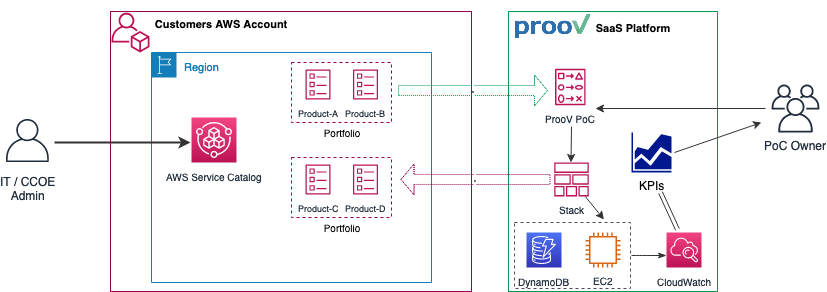
The PoC workflow is initiated by the IT/CCOE administrator team by creating a set of resource templates required to conduct the PoC on prooV platform. After the execution of the PoC the tested configuration is exported to AWS Service Catalog to enable self-service distribution for the end-users. There are three phases in the workflow:
- Create a portfolio in the AWS Service Catalog and add a baseline pre-configured AWS CloudFormation template as a Service Catalog product to build Amazon DynamoDB table and Amazon EC2 instance.
- Import the product into the prooV PoC-as-a-Service platform, deploy resources, execute the PoC, review the metrics, and determine the configuration rightsized for the use case.
- Export the evaluated PoC template from prooV PoC-as-a-Service Platform to your AWS Service Catalog PoC portfolio for standardization, self-service and deployment.
How to use PoC-as-a-Service solution using prooV and AWS Service Catalog
Follow these steps to use the PoC-as-a-Service solution:
Step 1: Sign-up for prooV’s PoC-as-a-Service on the registration page as an enterprise and enter the required details.
Step 2: Follow the instructions in your registration confirmation email to set up your account. Log into the prooV platform.
Step 3: Login to AWS Service Catalog console as an Administrator and create a baseline portfolio. Add the appropriate CloudFormation templates for your Amazon DynamoDB and Amazon EC2 instances as a product to ensure your newly added product is compliant with your enterprise’s security and governance policies.
To setup the baseline templates that can be imported into the prooV PoC platform, the Administrator performs the following tasks:
- Create an AWS Service Catalog portfolio named prooV_PoC_Baseline_Portfolio.
- For this example, download the CloudFormation template from prooV PoC Library.
- Create an AWS Service Catalog Product Amazon DynamoDB and EC2 using the downloaded template and add it to the portfolio.
- Note the “Portfolio ID” for prooV_PoC_Baseline_Portfolio that will be used to share the portfolio when creating the PoC on prooV platform at later steps.
Step 4: On the prooV home page, go to the My PoCs screen and choose Create a PoC. On the Create a new PoC page, enter the required details such as PoC Name, Category, project timelines, Description, Goals, Evaluation Criteria, and Instructions.
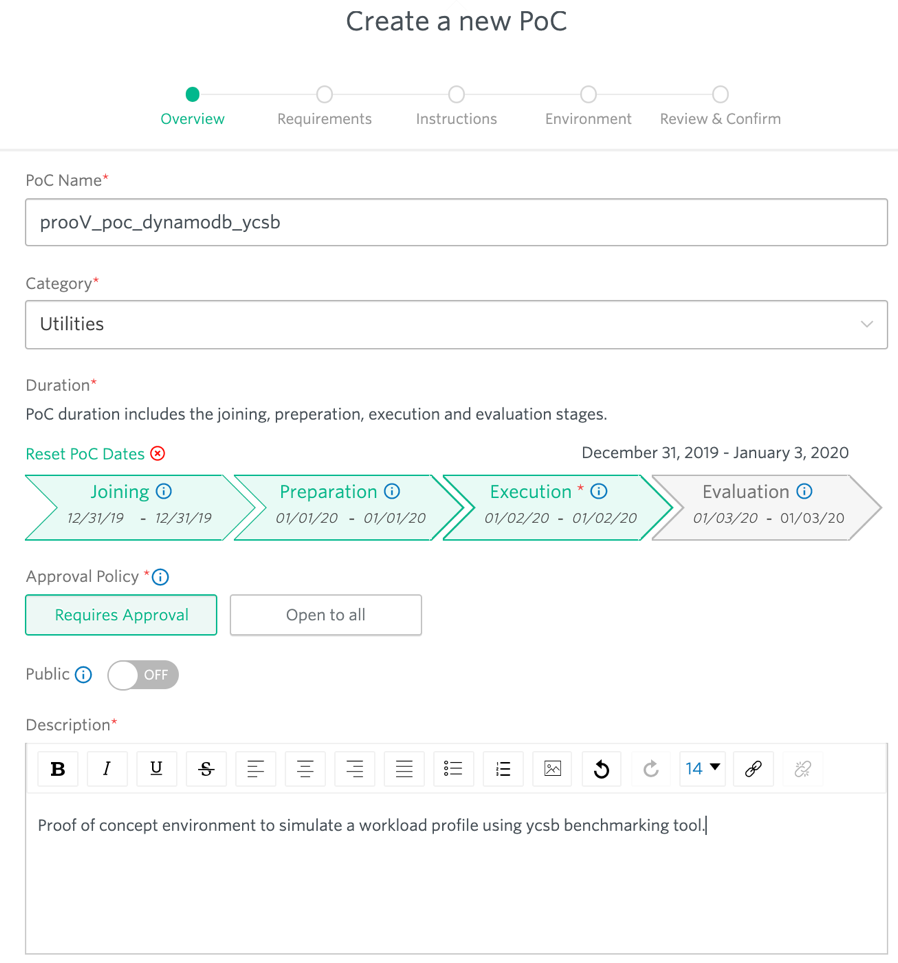
Step 5: On the “Share Your Service Catalog Portfolio” page, provide the “Portfolio ID” noted in the Step 3 to share the prooV_PoC_Baseline_Portfolio with your prooV PoC environment. Prior to clicking next, please make note of the “Account ID” shown on the page as this is needed for sharing the portfolio in Step 6.

Step 6: In a different browser window, login into the AWS Service Catalog Console and share the portfolio prooV_PoC_Baseline_Portfolio with the prooV account ID noted in the Step 5.

Confirm the portfolio is shared successfully.

Step 7: Return to the prooV PoC creation browser window opened in Step 5, review the description, set PoC duration, and instructions to run the PoC to the complete the PoC creation process. The prooV platform imports the Amazon DynamoDB and Amazon EC2 CloudFormation templates from the shared Service Catalog portfolio prooV_PoC_Baseline_Portfolio added in the Step 3.
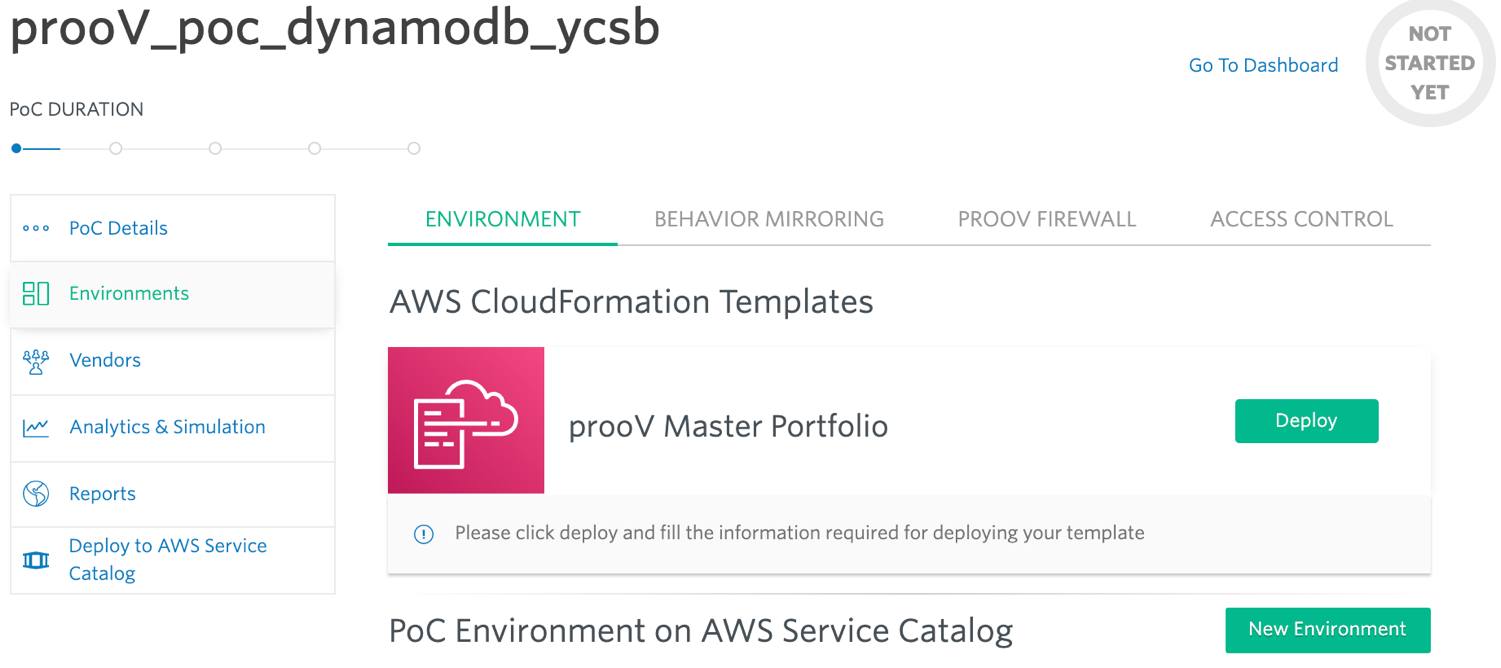
Step 8: Enter and verify the parameters for VPC id, instance size, public subnet Id for the Amazon DynamoDB instance and deploy the CloudFormation template in the prooV PoC environment.

Once the PoC environment is successfully deployed, the prooV console provides details on how to access the environment. At this stage, you are ready to run the tests on your PoC environment. For comparison of performance behavior between two Amazon EC2 instance types, you can add a second PoC environment by following the Steps 3-8 and selecting a different Amazon EC2 instance type.
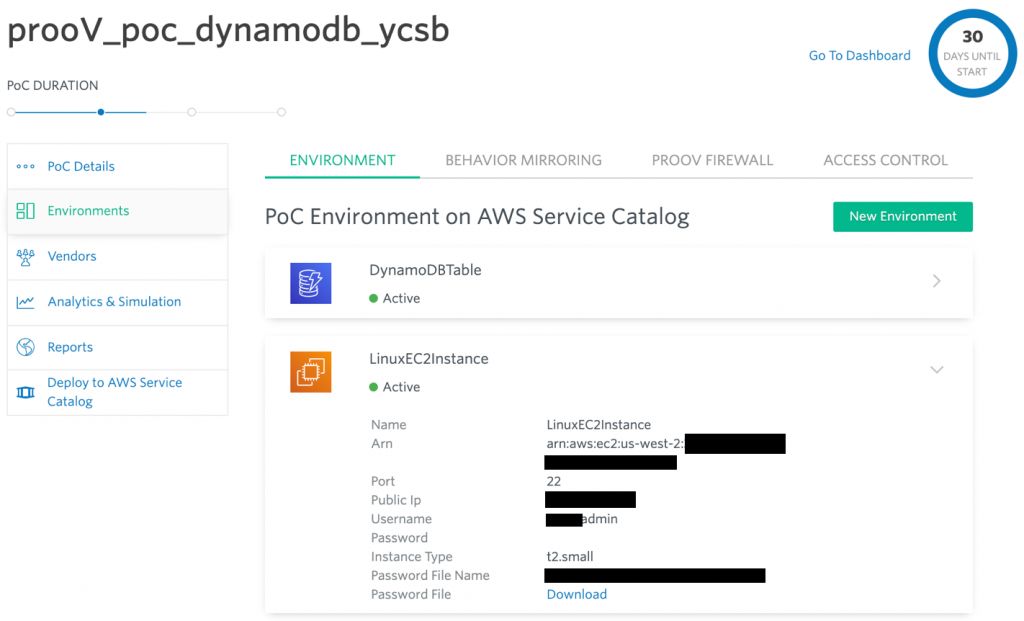
Step 9: To execute the PoC, run YCSB performance tests on the Amazon DynamoDB instance deployed using the prooV platform in the Step 8. First, login to the EC2 instance using information from the Environment page. Follow the YCSB installation instructions to setup the YCSB workload in the EC2 instance. Navigate to the YCSB “Running a Workload” page to setup the test parameters. From the “Core Workloads” page identify and run the appropriate workload to test the behavior of your PoC environment.
The test behavior and Amazon DynamoDB metrics can be accessed from the Analytics & Simulation. You could also define the Business KPIs based of these metrics. Below are few example analytics from YCSB Benchmarking test.
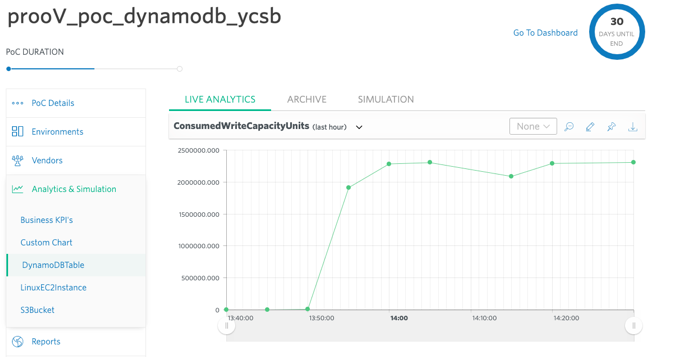
Exporting the PoC environment to AWS Service Catalog
Once the PoC is complete, the template can be exported from the prooV platform. This is achieved by creating an AWS Service Catalog portfolio, and associating the products by attaching the AWS CloudFormation templates generated on the prooV PoC platform.
Step 10: Use the “Deploy to Service Catalog” option on the prooV PoC page to export the template from the prooV platform to AWS Service Catalog. In order to export a PoC environment, you need to provide the following parameters:
- AWS account ID: The AWS account where validated/tested template will be deployed.
- AWS Access key ID and AWS Secret Access key: Access key the IAM user with AWSServiceCatalogAdminFullAccess role. prooV will use the access key to assign programmatic requests to the AWS CLI or AWS API. (keys for root user should not be used).


Step 11: To verify the successful import of the template, login to your AWS Service Catalog console and confirm the creation of the portfolio and product you exported from the prooV platform. Now you can enable self-service in the AWS Service Catalog for your end-users to deploy the validated PoC template at scale.

Conclusion
In this blog post, you learned how to simplify the PoC evaluation process in the AWS Cloud by using prooV PoC-as-a-Service platform and AWS Service Catalog. The example Amazon DynamoDB user case shows you how to use prooV platform, you can use prooV PoC-as-a-Platform solution for several key use cases such as Artificial Intelligence (AI), Internet of Things (IoT), and Business Intelligence (BI), to speed-up your PoC process.
Authors
Toby Olshanetsky
 prooV CEO and Co-founder Toby Olshanetsky has 20+ years of senior management experience (CEO & board member) and diverse technology background in cyber & IT security, social network, mobile, SaaS, e-commerce and online banking. As a serial entrepreneur, Toby co-founded and led several successful startups, raised over $60m, lead significant contract negotiations for strategic partnerships, key customers, JVs and M&As. He hand-picked and successfully recruited marketing, sales and R&D teams. Prior to prooV, Toby co-founded ULEI, Rocket Finance, MIC Mobile Security, DMCredit, and Neteye, a world leader in Cyber – IP Fraud management & detection. Toby also held key executive positions at Formula – Emblaze, Telmap and Shiron Satellite communication, and is the Chairman of Mindojo.
prooV CEO and Co-founder Toby Olshanetsky has 20+ years of senior management experience (CEO & board member) and diverse technology background in cyber & IT security, social network, mobile, SaaS, e-commerce and online banking. As a serial entrepreneur, Toby co-founded and led several successful startups, raised over $60m, lead significant contract negotiations for strategic partnerships, key customers, JVs and M&As. He hand-picked and successfully recruited marketing, sales and R&D teams. Prior to prooV, Toby co-founded ULEI, Rocket Finance, MIC Mobile Security, DMCredit, and Neteye, a world leader in Cyber – IP Fraud management & detection. Toby also held key executive positions at Formula – Emblaze, Telmap and Shiron Satellite communication, and is the Chairman of Mindojo.
Alexey Sapozhnikov
 prooV CTO and Co-founder Alexey Sapozhnikov is a serial entrepreneur with 20+ years of R&D experience in the domains of big data real-time analysis and crash prevention, user engagement algorithms and performance monitoring, cloud technologies, mobile security and enterprise systems. He co-founded and acted as CTO at Uppspace Cloud Technologies (acquired by Forthscale in 2014). The venture was backed by the Office of Chief Scientist of Israel. Alexey also co-founded and acted as CEO / CTO at HighTechForMe Outsourcing Services (acquired in 2011), and co-founded and acted as CTO at Gimao Networks, a pioneer in the domain of user engagement for various blog and news networks. Alexey held various executive technological positions at prominent software vendors: SAP Labs Israel (NASDAQ:SAP), MIND CTI (NASDAQ : MNDO), GE Medical Systems and Kamoon Software.
prooV CTO and Co-founder Alexey Sapozhnikov is a serial entrepreneur with 20+ years of R&D experience in the domains of big data real-time analysis and crash prevention, user engagement algorithms and performance monitoring, cloud technologies, mobile security and enterprise systems. He co-founded and acted as CTO at Uppspace Cloud Technologies (acquired by Forthscale in 2014). The venture was backed by the Office of Chief Scientist of Israel. Alexey also co-founded and acted as CEO / CTO at HighTechForMe Outsourcing Services (acquired in 2011), and co-founded and acted as CTO at Gimao Networks, a pioneer in the domain of user engagement for various blog and news networks. Alexey held various executive technological positions at prominent software vendors: SAP Labs Israel (NASDAQ:SAP), MIND CTI (NASDAQ : MNDO), GE Medical Systems and Kamoon Software.